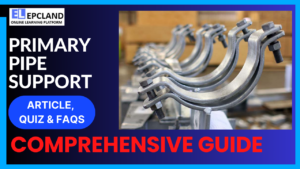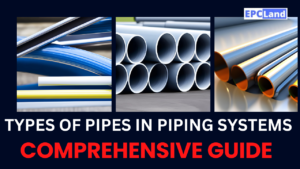Introduction to ASTM A312 Standard
In the world of manufacturing and engineering, standards play a vital role in ensuring consistency, quality, and safety across various industries. One such standard is ASTM A312, which is a cornerstone in the realm of stainless steel pipes. The American Society for Testing and Materials (ASTM) is a globally recognized organization that sets standards for materials, products, systems, and services. ASTM A312, specifically, focuses on seamless and welded stainless steel pipes used for high-temperature and corrosive applications. This article delves into the details of ASTM A312, from its technical specifications to its widespread applications and future trends.
Table of Contents
Do not miss the detailed course 7 Modules of Piping Codes & Standards
Enrollment link
Check out the Similar Articles on ASTM Standards
Understanding ASTM A312
Definition and Scope
ASTM A312: A Standard for Austenitic Stainless Steel Pipes
ASTM A312 is a standard specification for seamless, welded, and heavily cold worked austenitic stainless steel pipes. It covers a wide range of pipe sizes, from small-diameter tubes to large-diameter, heavy-wall pipes. The standard encompasses both seamless and welded pipes, ensuring that various manufacturing methods are accommodated while maintaining specific quality benchmarks.
ASTM A312 pipes are used in a variety of applications, including:
- Power generation
- Chemical processing
- Oil and gas
- Food and beverage
- Pharmaceutical
- Marine
- Aerospace
The standard includes requirements for chemical composition, mechanical properties, heat treatment, dimensions, tolerances, and testing. ASTM A312 pipes are typically made from austenitic stainless steels, such as 304, 316, and 321. These steels are characterized by their high chromium content, which gives them excellent corrosion resistance.
ASTM A312 pipes are an important part of many industrial systems. They are used to transport fluids, gases, and slurries in a variety of environments. The standard helps to ensure that these pipes are of high quality and can withstand the demanding conditions of industrial use.
1. ASTM A312 Standard
What does ASTM A312 cover?
Explanation: ASTM A312 covers seamless, welded, and heavily cold worked austenitic stainless steel pipes.
2. ASTM A312 Applications
In which of the following industries are ASTM A312 pipes commonly used?
Explanation: ASTM A312 pipes are commonly used in industries such as power generation, chemical processing, oil and gas, and more.
3. Characteristics of ASTM A312 Pipes
Which type of stainless steels are typically used for ASTM A312 pipes?
Explanation: ASTM A312 pipes are typically made from austenitic stainless steels, such as 304, 316, and 321.
Classification and Grades
ASTM A312 categorizes stainless steel pipes based on their manufacturing method and chemical composition, encompassing grades like TP304, TP316, TP321, and more. The classification of these grades hinges on their chromium and nickel content, which dictates their resistance to corrosion and high temperatures.
For example, TP304, with its 18% chromium and 8% nickel content, finds suitability in general corrosive environments. In contrast, TP316, boasting 16% chromium and 10% nickel, exhibits enhanced corrosion resistance in chloride-rich environments.
Here’s a table summarizing the classification and grades of ASTM A312 stainless steel pipes:
| Grade | Chromium Content (%) | Nickel Content (%) | Applications |
|---|---|---|---|
| TP304 | 18 | 8 | General corrosive environments |
| TP316 | 16 | 10 | Chloride-rich environments |
| TP321 | 17 | 10 | Austenitic stainless steel with added titanium for enhanced resistance to sensitization |
| TP347 | 18 | 10 | Austenitic stainless steel with added niobium or tantalum for enhanced resistance to sensitization |
This classification system ensures that users can select the appropriate grade of ASTM A312 stainless steel pipe based on their specific application requirements.
1. ASTM A312 Grade Classification
What does the classification of ASTM A312 grades depend on?
Explanation: ASTM A312 grades are classified based on their manufacturing method and chemical composition.
2. TP304 Grade
What is the chromium content (%) of ASTM A312 TP304?
Explanation: ASTM A312 TP304 has a chromium content of 18%.
3. TP316 Grade
What type of environments does ASTM A312 TP316 exhibit enhanced corrosion resistance in?
Explanation: ASTM A312 TP316 exhibits enhanced corrosion resistance in chloride-rich environments.
4. TP321 Grade
What additional element is present in ASTM A312 TP321 for enhanced resistance to sensitization?
Explanation: ASTM A312 TP321 contains added titanium for enhanced resistance to sensitization.
5. TP347 Grade
What is added to ASTM A312 TP347 for enhanced resistance to sensitization?
Explanation: ASTM A312 TP347 contains added niobium or tantalum for enhanced resistance to sensitization.
Key Features and Characteristics
ASTM A312-compliant pipes stand out for their exceptional characteristics, rendering them indispensable in various industries.
- Corrosion Resistance: ASTM A312 pipes are renowned for their exceptional resistance to corrosion, making them a preferred choice for applications in harsh environments that involve exposure to chemicals, saltwater, or other corrosive substances. Their austenitic microstructure and high chromium content contribute to their remarkable ability to withstand corrosion.
- High-Temperature Strength: These pipes exhibit outstanding strength at elevated temperatures, ensuring their suitability for applications that involve high heat exposure. Their austenitic structure and alloying elements, such as chromium and nickel, maintain their structural integrity and prevent deformation or failure under high-temperature conditions.
- Toughness and Ductility: ASTM A312 pipes possess admirable toughness and ductility, enabling them to withstand impact loading and deformation without cracking or breaking. Their austenitic microstructure contributes to their ability to deform without fracturing, making them suitable for applications that demand flexibility and resilience.
- Ease of Fabrication: These pipes are relatively easy to fabricate, allowing for efficient manufacturing and customization. Their austenitic structure and lack of significant phase transformations during welding or forming operations make them amenable to various fabrication techniques, such as welding, bending, and forming.
- Versatility and Wide Range of Applications: ASTM A312 pipes are available in a wide range of grades, sizes, and schedules, making them versatile and adaptable to diverse industrial applications. They are commonly employed in power generation, chemical processing, oil and gas, food and beverage, pharmaceutical, marine, and aerospace industries.
- Adherence to ASTM Standards: ASTM A312 pipes adhere to stringent ASTM standards, ensuring consistent quality and performance. This adherence to established standards guarantees that users can rely on the pipes to meet specific performance requirements and withstand the demands of various applications.
1. Corrosion Resistance of ASTM A312 Pipes
What makes ASTM A312 pipes a preferred choice for applications in harsh environments?
Explanation: ASTM A312 pipes are renowned for their exceptional resistance to corrosion, making them a preferred choice for applications in harsh environments.
2. High-Temperature Strength of ASTM A312 Pipes
What contributes to the outstanding strength of ASTM A312 pipes at elevated temperatures?
Explanation: The austenitic structure and alloying elements, such as chromium and nickel, contribute to the outstanding strength of ASTM A312 pipes at elevated temperatures.
3. Ease of Fabrication of ASTM A312 Pipes
Why are ASTM A312 pipes relatively easy to fabricate?
Explanation: ASTM A312 pipes are relatively easy to fabricate due to their austenitic structure and lack of significant phase transformations during welding or forming operations.
Technical Specifications of ASTM A312
Dimensions and Tolerances
The dimensions and tolerances specified in ASTM A312 ensure uniformity and compatibility among pipes from different manufacturers. The standard covers a wide range of pipe sizes, from NPS 1/8 to NPS 30 (Nominal Pipe Size), with varying wall thicknesses. Additionally, the standard defines tolerances for outside diameter, wall thickness, length, straightness, and ovality, ensuring that pipes meet the required specifications for their intended use.
Material Requirements
ASTM A312 stipulates strict requirements for the chemical composition of stainless steel pipes. The composition of the steel must adhere to specific percentages of elements such as chromium, nickel, carbon, manganese, and others. This ensures that the pipes exhibit the desired corrosion resistance, mechanical properties, and suitability for high-temperature applications. The standard also provides guidelines for heat treatment processes to achieve the required properties.
Testing Methods
To ensure the quality and integrity of pipes, ASTM A312 outlines various testing methods that must be performed during the manufacturing process. These include non-destructive tests such as ultrasonic testing and eddy current testing to detect defects, as well as destructive tests like tensile testing and hardness testing to assess mechanical properties. These tests serve as crucial checkpoints to ensure that the pipes meet the specified requirements and are safe for their intended applications.
Corrosion Resistance and Specialized Environments
ASTM A312-compliant pipes are designed to withstand corrosion in various environments, ranging from mild to highly corrosive. The standard specifies the minimum levels of corrosion resistance that the pipes must exhibit, ensuring that they remain structurally sound and functional over their intended service life. For applications involving extremely corrosive environments, higher-grade stainless steel alloys may be recommended to enhance durability and longevity.
1. Dimensions and Tolerances
What does ASTM A312 ensure regarding dimensions and tolerances of pipes?
Explanation: ASTM A312 ensures uniformity and compatibility among pipes from different manufacturers in terms of dimensions and tolerances.
2. Material Requirements
What does ASTM A312 stipulate regarding the chemical composition of stainless steel pipes?
Explanation: ASTM A312 stipulates strict requirements for the chemical composition of stainless steel pipes, specifying percentages of elements such as chromium, nickel, carbon, and others.
3. Testing Methods
What kind of tests are outlined in ASTM A312 to ensure the quality and integrity of pipes?
Explanation: ASTM A312 outlines various testing methods, including non-destructive tests (e.g., ultrasonic testing) and destructive tests (e.g., tensile testing), to ensure the quality and integrity of pipes.
4. Corrosion Resistance and Specialized Environments
What does ASTM A312-compliant pipes aim to withstand regarding corrosion?
Explanation: ASTM A312-compliant pipes are designed to withstand corrosion in various environments, ranging from mild to highly corrosive.
Do not miss the detailed course 7 Modules of Piping Codes & Standards
Enrollment link
Chemical Composition
Here is a representative chemical composition of stainless steel pipes meeting the ASTM A312 standard:
| Grade | Chromium (Cr) % | Nickel (Ni) % | Carbon (C) % | Manganese (Mn) % | Others |
|---|---|---|---|---|---|
| TP304 | 18.0 – 20.0 | 8.0 – 11.0 | ≤ 0.08 | ≤ 2.0 | – |
| TP316 | 16.0 – 18.0 | 10.0 – 14.0 | ≤ 0.08 | ≤ 2.0 | – |
| TP321 | 17.0 – 19.0 | 9.0 – 12.0 | ≤ 0.08 | ≤ 2.0 | Ti 5xC 0.7 |
Mechanical and Chemical Properties
Here are some representative mechanical and chemical properties of stainless steel pipes meeting the ASTM A312 standard:
Mechanical Properties:
| Grade | Tensile Strength (MPa) | Yield Strength (MPa) | Elongation (%) | Hardness (Brinell) |
|---|---|---|---|---|
| TP304 | ≥ 515 | ≥ 205 | ≥ 35 | ≤ 192 |
| TP316 | ≥ 515 | ≥ 205 | ≥ 35 | ≤ 192 |
| TP321 | ≥ 515 | ≥ 205 | ≥ 30 | ≤ 192 |
Chemical Properties:
| Grade | C % | Si % | Mn % | P % | S % | Cr % | Ni % | Mo % |
|---|---|---|---|---|---|---|---|---|
| TP304 | ≤ 0.08 | ≤ 1.0 | ≤ 2.0 | ≤ 0.045 | ≤ 0.030 | 18-20 | 8-11 | – |
| TP316 | ≤ 0.08 | ≤ 1.0 | ≤ 2.0 | ≤ 0.045 | ≤ 0.030 | 16-18 | 10-14 | 2-3 |
| TP321 | ≤ 0.08 | ≤ 1.0 | ≤ 2.0 | ≤ 0.045 | ≤ 0.030 | 17-19 | 9-12 | – |
Manufacturing Process
The manufacturing process for ASTM A312-compliant pipes involves several stages:
- Raw Material Selection: High-quality stainless steel billets are chosen based on their chemical composition and suitability for the intended application.
- Forming: The billets are heated and pierced to create hollow tubes, which are then elongated and reduced in diameter through processes like hot rolling or cold drawing.
- Welding (for Welded Pipes): For welded pipes, the edges of the flat strip or plate are joined using various welding techniques, such as TIG or MIG welding, to form a continuous pipe.
- Heat Treatment: Both seamless and welded pipes undergo heat treatment processes, such as solution annealing, to achieve the desired mechanical properties and corrosion resistance.
- Finishing: Pipes are then subjected to processes like pickling, passivation, and polishing to improve their surface finish and remove any contaminants.
- Testing and Inspection: Pipes undergo various tests, including non-destructive testing and mechanical testing, to ensure they meet the requirements of ASTM A312.
1. Raw Material Selection
What is the first stage in the manufacturing process of ASTM A312-compliant pipes?
Explanation: The first stage in the manufacturing process is Raw Material Selection, where high-quality stainless steel billets are chosen based on their chemical composition and suitability.
2. Forming Process
How are hollow tubes created in the forming stage of the manufacturing process?
Explanation: Hollow tubes are created in the forming stage by processes like hot rolling or cold drawing.
3. Welding in Manufacturing Process
For welded pipes, how are the edges of the flat strip or plate joined?
Explanation: For welded pipes, the edges of the flat strip or plate are joined using various welding techniques, such as TIG or MIG welding.
A312 vs. Other ASTM Standards
A312 vs. A358
While both ASTM A312 and A358 standards pertain to stainless steel pipes, there are distinct differences between the two. ASTM A312 covers seamless and welded pipes, whereas ASTM A358 specifically addresses electric-fusion-welded (EFW) pipes. The EFW process used in A358 pipes involves welding without the addition of filler material, resulting in pipes that are suitable for high-temperature and corrosive applications.
A312 vs. A269 and A511
ASTM A269 and A511 are standards that also deal with stainless steel tubes, but they differ from A312 in terms of their focus and applications. A269 pertains to seamless and welded austenitic stainless steel tubing for general service, whereas A511 focuses on mechanical tubing made from stainless steel. While A269 is used for general-purpose applications, A312’s scope is broader, encompassing pipes for high-temperature and corrosive environments.
Choosing the appropriate ASTM standard depends on the specific requirements of the application, considering factors such as operating conditions, material properties, and manufacturing processes.
1. ASTM A312 vs. A358
What is the primary difference between ASTM A312 and A358 standards?
Explanation: ASTM A312 covers seamless and welded pipes, while ASTM A358 specifically addresses electric-fusion-welded (EFW) pipes.
2. A312 vs. A269 and A511
What distinguishes ASTM A269 and A511 from ASTM A312 in terms of stainless steel tubes?
Explanation: A269 pertains to seamless and welded austenitic stainless steel tubing for general service, whereas A511 focuses on mechanical tubing made from stainless steel. A312’s scope is broader, encompassing pipes for high-temperature and corrosive environments.
3. Choosing ASTM Standards
What factors should be considered when choosing the appropriate ASTM standard, such as A312, A269, or A511?
Explanation: Choosing the appropriate ASTM standard depends on factors such as operating conditions, material properties, and manufacturing processes.
Do not miss the detailed course 7 Modules of Piping Codes & Standards
Enrollment link
Compliance and Certification
Importance of Adhering to ASTM A312 Specifications
Adherence to ASTM A312 specifications is crucial for ensuring the performance, safety, and longevity of stainless steel pipes. Meeting the requirements set forth by the standard guarantees that the pipes possess the necessary corrosion resistance, mechanical strength, and structural integrity to withstand the challenges of their intended applications.
Certification and Testing Processes
Manufacturers producing ASTM A312-compliant pipes must undergo rigorous testing and certification processes. This involves conducting various tests, such as hydrostatic testing to verify the pipes’ pressure-bearing capacity and non-destructive tests to identify defects. Certification documents provide information about the pipes’ compliance with ASTM A312 standards, including details about the manufacturing process, chemical composition, and mechanical properties.
Role of Third-Party Inspections
Third-party inspections play a vital role in verifying the accuracy of certification documents and ensuring that the manufactured pipes indeed meet the ASTM A312 requirements. Independent inspection agencies evaluate the pipes’ quality, compliance, and safety, providing an unbiased assessment that builds confidence among buyers and end-users.
1. Definition and Scope
What is the significance of adhering to ASTM A312 specifications for stainless steel pipes?
Explanation: Adhering to ASTM A312 specifications ensures corrosion resistance, mechanical strength, and structural integrity of stainless steel pipes.
2. Compliance and Certification
What information do certification documents for ASTM A312-compliant pipes provide?
Explanation: Certification documents for ASTM A312-compliant pipes provide details about compliance with ASTM A312 standards, manufacturing process, chemical composition, and mechanical properties.
3. Importance of Adhering to ASTM A312 Specifications
What role do third-party inspections play in the ASTM A312 compliance process?
Explanation: Third-party inspections play a vital role in verifying certification documents and ensuring that pipes meet ASTM A312 requirements.
Global Significance of ASTM A312
Acceptance and Adoption Worldwide
ASTM standards, including A312, have gained international acceptance and recognition. Many countries and industries worldwide rely on these standards to ensure uniformity, quality, and safety. The global recognition of ASTM A312 ensures that pipes manufactured in one region can be used in projects and applications around the world with confidence.
Influence on International Trade and Industry Standardization
ASTM A312’s influence extends beyond individual applications; it also plays a significant role in international trade. When pipes meet standardized specifications, barriers to trade are reduced, and the risk of substandard products entering the market decreases. The standardization of materials and products promotes fair competition and enhances the overall quality of the industry.
Future Trends and Developments
Evolving Industry Needs
As industries evolve and demand new capabilities from materials and products, ASTM A312 standards may need to adapt to meet these changing needs. For instance, emerging technologies in energy production, such as hydrogen fuel cells, may require specialized stainless steel pipes with unique properties to handle new challenges.
Potential Updates and Revisions
Standards are not static; they are subject to updates and revisions based on technological advancements, industry feedback, and changing regulations. ASTM A312 may undergo revisions to include new materials, testing methods, or requirements that better align with the evolving demands of industries.
Integration of New Materials and Technologies
The future may bring about the integration of new materials and technologies into the realm of ASTM A312-compliant pipes. Advances in metallurgy, coatings, and fabrication techniques could lead to the development of pipes with enhanced corrosion resistance, higher strength, and improved cost efficiency.
Do not miss the detailed course 7 Modules of Piping Codes & Standards
Enrollment link
Challenges and Limitations
Manufacturing Challenges
Producing pipes that meet the stringent requirements of ASTM A312 can be challenging. Maintaining the desired chemical composition, mechanical properties, and dimensional accuracy throughout the manufacturing process requires strict quality control and specialized equipment.
Environmental and Economic Considerations
The production of stainless steel pipes, while beneficial in many aspects, also has environmental implications. The extraction of raw materials, energy-intensive manufacturing processes, and waste generation pose sustainability challenges. Balancing economic viability with environmental responsibility is a key consideration for manufacturers and industries using ASTM A312 pipes.
Addressing Limitations and Gaps
No standard is without its limitations, and ASTM A312 is no exception. As industries push the boundaries of existing applications, potential gaps in the standard’s coverage may become apparent. It is essential for stakeholders to communicate such limitations and work collectively to address them through revisions and updates.
1. Definition and Scope
What is ASTM A312?
Explanation: ASTM A312 is a standard specification for seamless, welded, and heavily cold worked austenitic stainless steel pipes.
2. Manufacturing Challenges
What makes producing pipes that meet the stringent requirements of ASTM A312 challenging?
Explanation: Producing pipes that meet the stringent requirements of ASTM A312 is challenging due to the complexity of the manufacturing process requiring strict quality control and specialized equipment.
3. Environmental and Economic Considerations
What is a key consideration for manufacturers and industries using ASTM A312 pipes?
Explanation: Balancing economic viability with environmental responsibility is a key consideration for manufacturers and industries using ASTM A312 pipes, given the environmental implications of their production.
Ensuring Sustainability and Safety
Role in Promoting Sustainable Practices
Despite the challenges, ASTM A312 plays a role in promoting sustainability. By specifying quality requirements and ensuring the longevity of pipes, the standard indirectly contributes to reducing waste and the need for frequent replacements. Additionally, the recyclability of stainless steel contributes to its sustainability.
Environmental Impact and Lifecycle Assessment
A comprehensive assessment of the environmental impact of ASTM A312 pipes includes considering their entire lifecycle—from raw material extraction to manufacturing, transportation, usage, and eventual disposal or recycling. Such assessments aid in identifying areas for improvement and guiding decisions that minimize the environmental footprint.
Reduction of Failures, Accidents, and Hazards
Adhering to ASTM A312 standards significantly reduces the risk of failures, accidents, and hazards associated with using substandard pipes. In industries like petrochemicals, oil and gas, and power generation, where a pipe failure can lead to catastrophic consequences, the role of the standard in ensuring safety cannot be overstated.
Conclusion
ASTM A312 stands as a testament to the importance of standardized specifications in ensuring the quality, safety, and performance of stainless steel pipes. Its significance spans industries and geographies, influencing trade, safety, and technological advancement. As industries evolve, the standard will continue to adapt to meet new challenges and opportunities, shaping the future of stainless steel pipe manufacturing and applications. In a world where consistency and reliability are paramount, ASTM A312 remains a beacon of assurance.
FAQs about ASTM 312:
1. What does ASTM 312 stand for?
ASTM 312 stands for the American Society for Testing and Materials standard number 312, which outlines specifications for various materials used across industries.
2. Why is ASTM 312 essential in manufacturing?
ASTM 312 ensures that manufacturing processes utilize materials that meet stringent quality benchmarks, leading to safer and more reliable products.
3. How does ASTM 312 impact aerospace engineering?
In aerospace, ASTM 312 guarantees the quality and performance of materials, contributing to the safety and reliability of aircraft components.
4. Can ASTM 312 be applied to sustainable practices?
Yes, ASTM 312 extends its guidelines to eco-friendly materials, supporting sustainable manufacturing and resource management.
5. How does ASTM 312 influence regulatory compliance?
Regulatory bodies often refer to ASTM 312 standards, making compliance with these standards a strategic way to align with industry regulations.
6. Is ASTM 312 applicable internationally?
Absolutely, ASTM 312’s global recognition ensures that manufacturers worldwide can adhere to the same high standards.
Recommended courses (Published on EPCLand):
- Basics of Piping Engineering
- Piping Layout Engineering
- Piping Material Engineering
- Piping Stress Analysis
- Complete Course on Piping Engineering
- Material Requisitions
- Piping Material Specifications
- Valve Material Specifications
Related Video
Attempt Quiz
Question 1:
What does ASTM A312 refer to?
Explanation: ASTM A312 is a standard specification for seamless, welded, and heavily cold worked austenitic stainless steel pipes. It covers various grades of stainless steel pipes used in different industries.
Question 2:
What is the primary purpose of ASTM A312 stainless steel pipes?
Explanation: The primary purpose of ASTM A312 stainless steel pipes is to convey fluids and gases, making them suitable for applications such as pipelines and process industries.
Question 3:
Which grades of stainless steel are commonly covered by ASTM A312?
Explanation: ASTM A312 commonly covers austenitic stainless steel grades, which offer good corrosion resistance and high-temperature strength.
Question 4:
What is the key difference between ASTM A312 and ASTM A213?
Explanation: The key difference between ASTM A312 and ASTM A213 is that A312 covers pipes, while A213 covers seamless, welded, and heavily cold worked austenitic stainless steel tubes.
Question 5:
What properties make ASTM A312 stainless steel pipes suitable for high-temperature applications?
Explanation: ASTM A312 stainless steel pipes exhibit high temperature resistance and creep strength, making them suitable for applications involving elevated temperatures.



